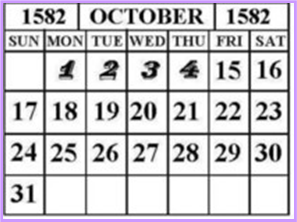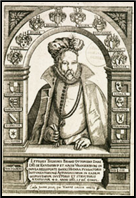


xxxxxThe Roman calendar, introduced by Julius Caesar in 46 B.C., proved over 11 minutes longer than the solar year. By 1582 there was a discrepancy of ten days, and in that year Pope Gregory XIII issued a decree scrapping the ten days and introducing the Gregorian calendar. Within two years all of Catholic Europe was using the “New Style”, but Protestant Europe and other countries were much slower in adopting the new method. The former Soviet Union, for example, did not change until 1918, and Turkey as late as 1927. Great Britain, as we shall see, adopted the calendar in 1752 (G2), but not without protest. Other religions, like Islam and Judaism have their own calendars based on their respective faiths.
THE GREGORIAN CALENDAR 1582 (L1)
Acknowledgements
Gregory XIII: detail, by the Italian painter Lavinia Fontana (1552-
xxxxxThe first Roman calendar was introduced in the 7th century B.C. but soon ran into trouble over the number of days required for each month. In 46 B.C. Julius Caesar introduced a purely solar calendar -
 xxxxxToxrectify this, in October of that year Pope Gregory XIII (illustrated) issued a decree scrapping ten days, and he then introduced the Gregorian calendar. This provided that only century years which were divisible by 400 (such as 1600) would be leap years. This calendar was adopted by the Papal States, Spain and Portugal in the year of its introduction, and by 1584 all of Catholic Europe was using the "New Style", as it was sometimes called. Unfortunately, Protestant Europe and other countries were much slower in adopting the new method. For example, the Soviet Union -
xxxxxToxrectify this, in October of that year Pope Gregory XIII (illustrated) issued a decree scrapping ten days, and he then introduced the Gregorian calendar. This provided that only century years which were divisible by 400 (such as 1600) would be leap years. This calendar was adopted by the Papal States, Spain and Portugal in the year of its introduction, and by 1584 all of Catholic Europe was using the "New Style", as it was sometimes called. Unfortunately, Protestant Europe and other countries were much slower in adopting the new method. For example, the Soviet Union -
 xxxxxAnd other complications remained. The Gregorian calendar is based on the Christian faith, with A.D. starting at the year of Christ's birth (though this is now believed to be four years out!). The Jewish calendar, on the other hand, takes 3761 B.C. as its starting point, the date of the beginning of the world according to the Old Testament. To make matters more confusing -
xxxxxAnd other complications remained. The Gregorian calendar is based on the Christian faith, with A.D. starting at the year of Christ's birth (though this is now believed to be four years out!). The Jewish calendar, on the other hand, takes 3761 B.C. as its starting point, the date of the beginning of the world according to the Old Testament. To make matters more confusing -
xxxxxBecause the Gregorian calendar still has months of varying length, a number of proposals for calendar reform have been put forward over the years. In 1954, for example, the so- he world's computers might be sufficient to give the idea a miss!
he world's computers might be sufficient to give the idea a miss!
xxxxxIncidentally, the change to the Gregorian Calendar in 1582 was only made possible by an accurate knowledge of the year's length. The skilled Danish astronomer Tycho Brahe was working at his observatory on the island of Hven at this time. By his observation of the sun, moon and planets over many years, he was able to determine the precise length of the year to within less than a second.
L1-


